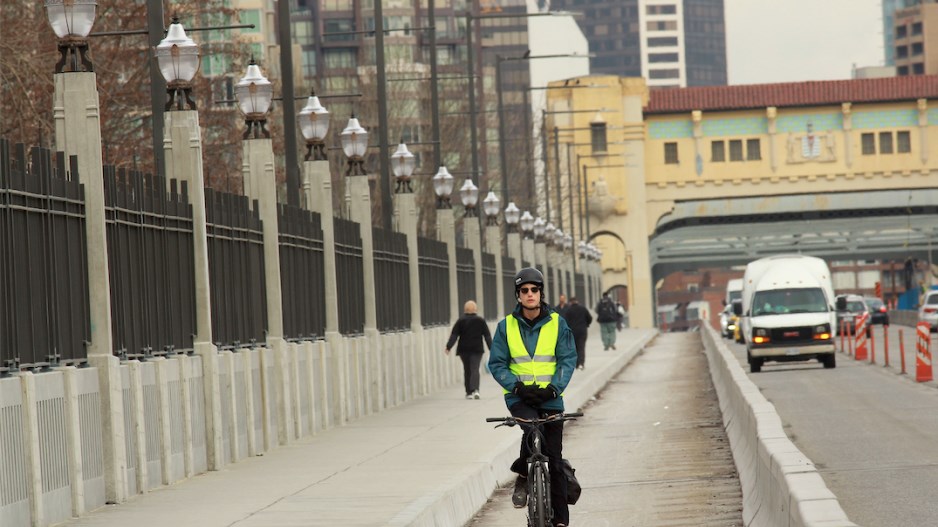In 2009, discussions about bike infrastructure in the city of Vancouver dominated radio airwaves and commentary pages.
It all began when a lane of traffic on Burrard Bridge was entirely devoted to cyclists. By the end of 2010, separated bike lanes followed on Hornby Street and Dunsmuir Street.
The early debate on separated bike lanes turned a city where politics had been an underwhelming spectacle – as outlined by the pitiful 31% voter turnout in the 2008 municipal election – into a place where suddenly everybody had a point of view.
The city relied on crafty images of cyclists in cities like Copenhagen, Portland and New York, to boost its case. Opponents pointed to perceived losses in revenue for businesses, sometimes with poorly designed and executed surveys. The so-called “war on the vehicle” coincided with hefty increases in parking fees, making it easier for drivers who could no longer find spots to blame the existence of the separated bike lanes for their misfortune.
A decade has passed, and the way Vancouverites feel about this issue is not as contentious as it may have appeared before. Across the city, almost seven in 10 residents (69%) recently told Research Co. that they support having separated bike lanes, while one in four (25%) are opposed and 5% are undecided.
The level of “strong support” for separated bike lanes is almost four times higher than the level of “strong opposition” (29% and 8% respectively). This indicates a particularly low number of purported “bike haters” in Vancouver.
It is no surprise to see Vancouverites who commute to school or work on their bicycle providing an overwhelming endorsement of separated bike lanes (90%). Still, majorities of residents who travel primarily on public transit (79%) or who drive to school or work (69%) are also in favour of this type of infrastructure. The so-called “war on the vehicle” is clearly not alive in present-day Vancouver.
There is no gender gap on this issue, but support for separated bike lanes does taper slightly with age, from an impressive high of 78% among Vancouverites aged 18 to 34, to 73% among those aged 35 to 54 and 59% among those aged 55 and over.
Some have attempted to point at a disparity in views across specific regions of the city, and the survey does show some movement. Still, not a single area actively sneers at separated bike lanes. Support is highest on the east side of Vancouver (73%), followed by downtown (69%) and the west side (66%).
When asked about the present and future of bike infrastructure, the views of residents vary more. While 40% of Vancouverites think the city has the right number of separated bike lanes, 30% believe there are too many and some should be removed, and 21% say there are not enough and more should be built.
The idea of a city that has too many bike lanes is more prevalent among men (36%) and Vancouverites aged 55 and over (33%). In a strange twist, the survey shows more east-siders feeling this way (36%) than west-siders (24%). In addition, while more than a third of drivers (37%) agree with the idea of removing some of the lanes we currently have in the city, they are joined by 25% of bicycle commuters and 21% of public transit users.
In any case, we are not witnessing overwhelming majorities of Vancouverites in any demographic that suggest paving over existing separated bike lanes – an idea proposed by the fourth-place finisher in the 2018 mayoral race.
As we look back, it is important to remember that the roll-out of Vancouver’s first few separated bike lanes could have been handled differently. The fact that a party single-handedly controlled City Council led to accusations of grandstanding. Posting construction notices before votes actually took place was provocative. Fans of the party saw this as proper planning. Opponents interpreted it as abuse.
Still, the legacy of the separated bike lanes in Vancouver is, so far, an encouraging one. A majority of residents regard them in a positive light, and there is division on whether more should be added in the future.
The project began at a time when few Vancouverites were taking action to deal with their own carbon footprint, when the “electric car” appeared to be effectively defunct and when the concept of car-sharing was in its infancy. Now, separated bike lanes are a part of the city’s infrastructure that is appealing not only to the cyclists who get to use them, but also to transit riders and drivers.
Results are based on an online study conducted from November 12–15, 2019, among 400 adults in the city of Vancouver. The data has been statistically weighted according to Canadian census figures for age, gender and region in the city of Vancouver. The margin of error, which measures sample variability, is plus or minus 4.9 percentage points, 19 times out of 20.



